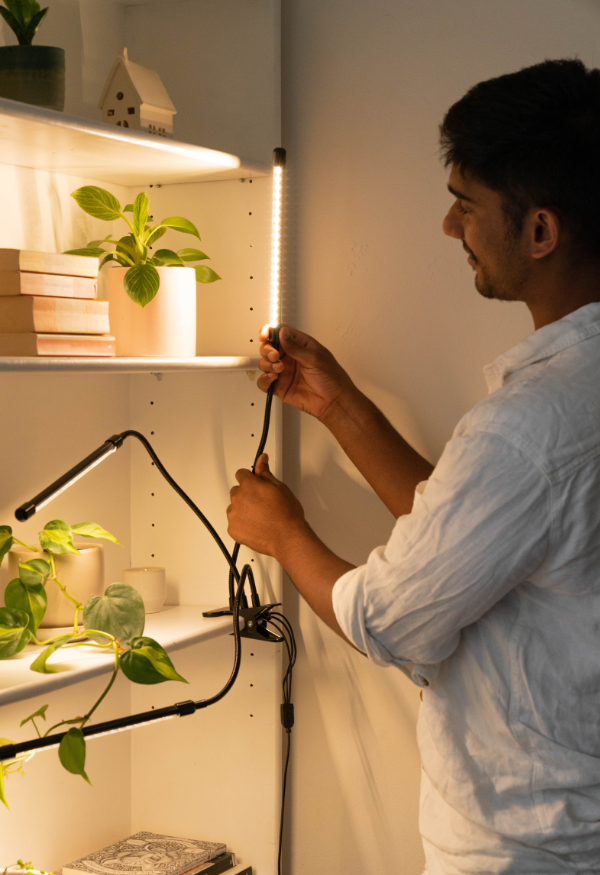Your Cart is Empty
shop
What Type Of Light Do Plants Need To Grow
June 02, 2022 4 min read

Hydroponic Grow Lights
Grow lights are electric lights which mimic the wavelength of light that plants need to grow so that plants can grow without the need for sunlight.
What type of light do plants need to grow?
Plants primarily require blue and red light between the 400-500 and 600-700nm wavelengths. Other portions of the light spectra are not always utilised by the plants! Which is why if you got a household light globe, it COULD grow a plant, but most likely wouldn't, as most of the light spectrum emitted is wasted by emitting light at the wrong wavelength.
While every plant has a slightly different requirement for light intensity, light spectrum, and the amount of exposure required, most hobbyists don’t need to go to that much detail to still get great results for their plant growth.
Every grow light we sell at Urban Plant Growers has been tested for their PPFD output to ensure they stand up to the test and can grow plants efficiently.
How are grow lights different to normal lights?
Light from the sun has a wide range of radiation that it emits, from gamma waves of all the way to longwave radio waves. The light that can be seen by humans makes up just a tiny fraction of the total spectrum and is referred to as the “visible spectrum”.

Credit: Lumitex
When we talk about the effectiveness of lights for normal household use, we often use Lux or Lumens as a metric, however this is not the correct measurement for grow lights. When you look at the spectrum for which lux is measured, you can see that it peaks in the green and yellow wavelengths, which humans can see more brightly than other colours! These wavelengths aren’t as important for plant growth, in fact, plants reflect green light – which is why our eyes see them as green. When measuring grow lights, you need to look at the amount of light that falls within 400 and 700 nm, or the Photosynthetically active radiation (PAR) scale.
The image below shows the wavelength spectrum of a few common types of light. As you can see, there is a bit of variation between the wavelengths produced by daylight (which has a large amount of all wavelengths) compared to something like fluorescent light (which has a few very narrow bands of light which when combined appear white.
The common thing between all the lights below (excluding sunlight) is that they are optimised to the human eye.
What do the different wavelengths of light do?
Blue Light (400-500nm)
Encourages photosynthesis and leads to bushier plants that don’t stretch of find more light. Good for growing in compact spaces
Red Light (600-700nm)
Tells the plant that it’s time to flower or fruit. Often plants under redder light will stretch and grow longer rather than grow short and bushy.
What about UV or infrared light?
UV and Infrared are helpful for improving plant cell quality, however it isnt necessary for all plant growth. Albeit not being necessary, it does have a range of benefits:
- Can sterilise/kill stuff like algae, bacteria, mould (UV-C specific).
- Can “stress” a plant, which advanced growers can use to their benefit. For example stressing a basil plant toward harvest time, may force the plant to hold onto its sugars and become sweeter!
Our grow lights don't emit UV or Infrared light.
How do you measure a grow light’s effectiveness?
As mentioned previously, grow lights have a different set of measurements compared to conventional household lights.
PAR
Photosynthetically active radiation. This is the spectrum of light between 400-700nm and is purely a scale which defines which portion of light we are measuring from.
PPF
Photon photosynthetic flux is a measure of the NUMBER of photons emitted by a light which are within the PAR range. PPF is measured in micromoles/second. Fun fact, a mole is 6.022 x 10^23 photons.
PPFD
Photon photosynthetic flux density. Basically how many of the units above are there per square metre. This is measured in micromoles/m2/second.
DLI
Daylight integral or DLI is the PPF x the amount of seconds on the day for which the plant receives that level of PPF. It’s a measure of the overall amount of photosynthetically active light that a plant receives in a day.
Other measurements
Here are some commonly used measurements for regular lights which aren’t necessarily appropriate for measuring the intensity of grow lights.
Lumens
This measures the total amount of visible light (to the human eye) emitted by a light source
Lux
This measures the amount of visible light (to the human eye) that lands on each square metre.
Kelvin
This measures the “temperature” of light, or the visual colour. Warm-reddish light has lower Kelvins whereas cool-bluish light has higher Kelvins. The measurement for this is in degrees Kelvin (not to be confused with temperature).
That's everything on what type of light plants need to grow. If you wan't to learn more, check out the rest of our series:
- Why Grow With Hydroponics
- What Nutrients Do Plants Need
- You are here -> What Type Of Light Do Plants Need To Grow
- How Much Light Do Plants Need
- LED Grow Lights V.S. Other Hydroponic Lights
- What Is Expanded Clay (Growing Medium)
- What Is Vermiculite (Growing Medium)
- What Is Perlite (Growing Medium)
- What Is Rockwool (Growing Medium)

Take $10 off your first order!
Grow lights, smart gardens, sprout kits and more - we've got all the tools you need to get growing in all the tricky places. Sign up to get your discount code!
